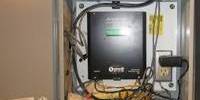Jason Petta, Ph.D., associate professor of physics at Princeton University, and researchers from the Emergent Phenomena in Quantum Systems project have created a device that is a step forward for silicon-based quantum computers. A gadget that allows a single electron to transmit quantum information to a light particle. The photon, or particle of light, can then operate as a messenger, carrying the information to other electrons and forming the circuits of a quantum computer.
According to Jason Petta, a Princeton professor of physics, the research, which was published in the journal Science and undertaken at Princeton and HRL Laboratories in Malibu, California, reflects a more than five-year effort to establish a strong capability for an electron to talk to a photon.
“Just like in human interactions, to have good communication a number of things need to work out it helps to speak the same language and so forth,” Petta said. “We are able to bring the energy of the electronic state into resonance with the light particle so that the two can talk to each other.”
Researchers will be able to use light in the form of photons to link individual electrons, which operate as bits, or the smallest units of data in a quantum computer, allowing the computers to tackle difficult queries that current computers cannot. Photons are more resistant to disruption and might potentially transport quantum information not only between qubits in a quantum computer circuit but also between quantum processors via cables. Quantum computers are powerful systems that, once achieved, would be able to conduct complex computations utilizing tiny particles such as electrons that operate according to quantum rules rather than the physical laws of the everyday world.
In a typical computer, each bit can have a value of 0 or 1. Qubits are quantum bits that can be in a state of 0, 1, or both a 0 and a 1 at the same time. This so-called superposition enables quantum computers to solve complicated problems that today’s computers can’t. Simple quantum computers have already been built utilizing trapped ions and superconductors, but silicon-based quantum devices have been sluggish to develop due to technical obstacles.
Silicon is a very appealing material because it is both cheap and widely used in today’s smartphones and computers. The researchers trapped an electron and a photon in the gadget, then changed the electron’s energy so that quantum information could be transferred to the photon. The photon may convey information from one qubit to another up to a centimeter away thanks to this interaction. Quantum information is highly sensitive, and even the tiniest environmental perturbation might cause it to be lost totally.
Although photons and quantum information are two very distinct sorts of particles, researchers needed to create a gadget that offered the ideal atmosphere for them to communicate. First, the semiconductor chip was made from layers of silicon and silicon-germanium by Peter Deelman at HRL Laboratories, a corporate research and development laboratory operated by the Boeing Company and General Motors. A single layer of electrons was trapped beneath the chip’s surface by this arrangement. Following that, Princeton researchers strung tiny wires across the top of the gadget, each just a fraction of the breadth of a human hair.
The researchers were able to transmit voltages that formed an energy landscape capable of catching a single electron and confining it in an area of silicon known as a double quantum dot using these nanometer-sized wires. The researchers utilized the same wires to match the trapped electron’s energy level to that of the trapped photon, which is trapped in a superconducting cavity constructed on top of the silicon wafer.
Semiconductor qubits could only be connected to nearby qubits before this discovery. It may be possible to transfer information between qubits at different ends of a chip by utilizing light to link them. The placement of the electron in one of two energy pockets in the double quantum dot is all that the electron’s quantum information consists of. The electron might fill either one or both of the pockets at the same time. The researchers can regulate which pocket the electron occupies by varying the voltages provided to the device.
The device’s performance is due to a new circuit design that brings the wires closer to the qubit and lowers interference from other electromagnetic sources. The researchers used filters to remove unwanted signals from the wires that lead to the gadget in order to reduce noise. The metal wires also shield the qubit. As a result, the qubits utilized in prior research are 100 to 1000 times less noisy. The researchers hope to eventually expand the device to function with the electron’s spin, which is an intrinsic feature.
David DiVincenzo, a physicist at RWTH Aachen University’s Institute for Quantum Information who was not involved in the research, wrote an influential 1996 paper defining five minimum conditions for building a quantum computer. Of the Princeton-HRL work, in which he was not involved, DiVincenzo said:
“It has been a long struggle to find the right combination of conditions that would achieve the strong coupling condition for a single-electron qubit. I am happy to see that a region of parameter space has been found where the system can go for the first time into the strong-coupling territory.”















